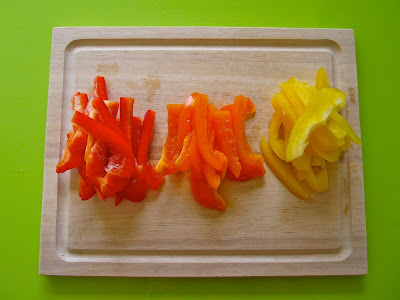These are just a few reason why I love vegetable stir fry. It also happens to be super healthy and super easy to make. So grab a wok, turn on the stove, and get ready to cook up somethin' soy delicious… Ha Ha Ha. Get it? Soy?

Shopping List:
1 sm. red pepper
1 sm. orange pepper
1 sm. yellow pepper
1 14 oz bag baby broccoli florets
1 cup brown rice
2 handfuls snow peas
2 8oz. cans sliced water chestnuts
4 lg. garlic cloves
From the Pantry:
1 tsp. ground ginger
1 Tbl. chinese five spice* (optional)
black pepper
1 Tbl. olive oil
Tools:
Wok or large frying pan
large pot
spatula
Preparation: Begin by thinly dicing garlic. Put garlic in wok on low heat. Allow garlic to brown for several minutes while you prep other veggies; after a few minutes garlic should appear brown and become very aromatic but heat should not be high enough to burn garlic pieces. In large pot, prepare rice according to package instructions. Depending on the type of rice you choose, the rice may take anywhere from 25 to 45 minutes to cook up so, go ahead and get that started while you cut up the rest of the components of your stir fry. Place 1 Tbl. olive oil in wok with browned garlic. Remove broccoli florets from bag and empty contents into wok. Increase heat to medium-low and add a Tbl. or two of water to wok if it seems like you need a little more moisture. Slice peppers, rinse and destring snow peas (snap off ends of snow peas and pull; many will have a string that comes off), and rinse off water chestnuts. Once broccoli has softened, place peppers and water chestnuts into wok. Let cook for about 5 to 7 minutes, stirring occasionally. Once peppers have begun to soften, add the snow peas. At this time, sprinkle vegetable medley with ginger, black pepper, and chinese five spice. Let mixture cook for another 5 minutes then remove from the heat. Once your rice is ready, you're ready to serve. Soy sauce is a classic addition to stir fry. I personally enjoy mine straight up. I find soy sauce to be over powering but… to each his own.
One of the things I love about stir fry is it's versatility. As I mentioned above, you can enjoy it with soy sauce or without. You may love mushrooms and choose to toss a few of those into this dish. I enjoy a little extra heat so I've been known to include a few red pepper flakes or be a little bit more generous with the ginger.
I'm such a fan of stir fry because it's always such a beautiful, colorful completed dish. It's filling and it's full of healthful ingredients that both my taste buds and my body can appreciate.
*Chinese five spice is a blend of cinnamon, star anise, fennel, ginger, cloves, white pepper and licorice root. It adds a sweetness to the dish which you may or may not like. I suggest you start by sprinkling a little on one completed dish to determine whether or not you want to incorporate CFS into your dish.
























